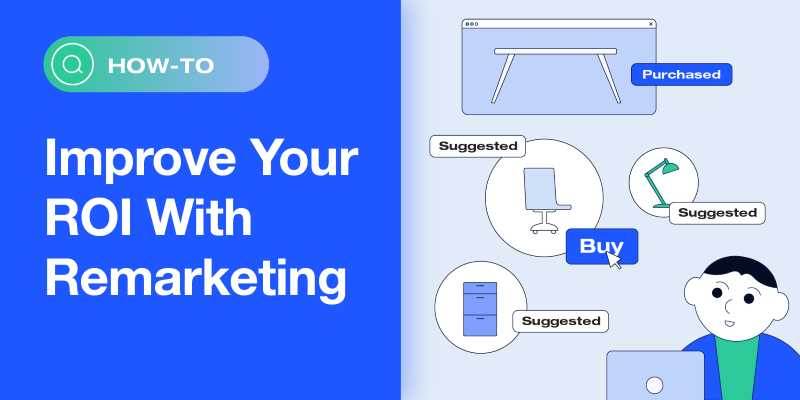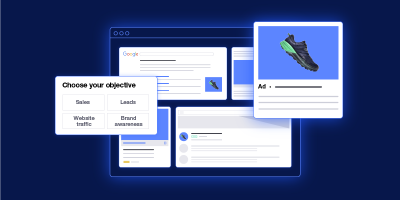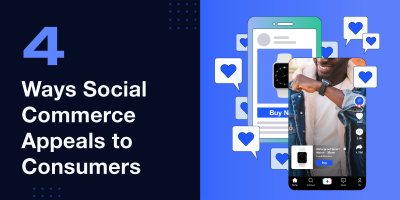Remarketing is a way for advertisers to reconnect with users who have previously interacted with their brand. It is often implemented using a remarketing tag (also known as a pixel) that tracks a potential customer’s actions in a web browser.
Why is remarketing so important?
Re-engaging with previous customers is cheaper than acquiring new ones. Targeting your existing customer base is an efficient use of your ad spend because they are familiar with your brand.
Remarketing also increases the likelihood of conversion because it allows you to share more relevant content with your target audience. A recent study showed that 91% of consumers are more likely to shop with brands that recognize, remember, and provide relevant offers and recommendations to them.
Do you want to get started with remarketing? Continue reading for everything you should know about remarketing and strategies you can use to improve your return on investment (ROI).
How does remarketing work?
As mentioned previously, remarketing is implemented by using a tracking tag that is placed in the code of your website. Each social media network or analytics platform has a different way of doing this.
Here are remarketing implementation tutorials for some of the most popular channels:
Google
Facebook
Pinterest
LinkedIn
Once the tag has been installed, the code logs users’ interactions when browsing your website. Potentially logged actions include:
- Adding an item to their shopping cart
- Clicking on a specific shopping category
- Tracking the behavior flow of a customer as they search and peruse your products
An important note about remarketing
In 2018, the EU adopted the General Data Protection Regulation to protect consumers’ privacy. To comply with these regulations, websites in certain countries and areas are required to allow customers to “opt-in” to the collection of their personal data. Currently, these rules do not apply to every country. Still, it is important for ecommerce merchants to stay on top of updates to their local privacy laws and regulations.
Creating remarketing lists
A remarketing list, also known as a custom audience, is a list of users who have completed a specific action on your website. With this information, you can create ad campaigns to target those users. For example, if you sell outdoor apparel, you can create a remarketing list of all the users who visit the hiking boot section of your website. Then you can create an ad campaign that promotes all of the boots you have on sale directly to these users.
Using custom audiences is an excellent way to segment your campaigns and ensure you provide relevant content to shoppers.
What are the benefits of remarketing?
Remarketing supports brand recognition.
In the saturated world of digital advertising, remarketing gives merchants an edge over competitors. By remarketing your products to users who have visited your website, you encourage brand loyalty by staying top of mind when a customer is searching for a similar product.
Remarketing improves ad relevancy.
The goal of digital marketing is to reach your customers at the right time. Remarketing allows you to avoid the digital “cold calls” and lets you strike when the iron is hot. A remarketing list gives you a sense of how far down the sales funnel a customer is, so you can provide the most relevant messaging.
Remarketing yields a higher ROI.
Seventy percent of customers say it’s important for brands to provide personalized experiences. Creating custom audiences allows you to segment your advertising campaigns to target smaller and more focused groups of users. Customers who have already purchased a standing desk from you will be far more receptive to an ad for compatible standing desk accessories, and they might get annoyed if you keep showing them ads for a product they already bought.
Remarketing helps you deliver a seamless, omnichannel experience.
The digital world is shifting towards omnichannel. More and more online businesses are looking to create a consistent brand experience for their customers across all platforms. Consumer data is imperative for creating this personalized experience, and remarketing is an easy first step to achieving this.
Interested in adopting an omnichannel strategy?
Four remarketing tips for improving your ROI
- Upsell to existing customers
Keep your existing customers in the know about products related to their past purchases. Use remarketing to target this group with ads for products that complement your other services. You can also entice your customers to upgrade their current product selection by promoting the added benefits of your premium offerings.
- Target users within a specific time period of an interaction or purchase
How long does it take for one of your customers to reach a purchasing decision? Take this into account when you set up a remarketing list. If the purchase decision process for your product takes a week, use this opportunity to set up your remarketing parameters to target customers who have interacted with your product within seven days. This helps remind customers about your brand and nudges them towards completing a purchase.
- Target users who have abandoned their online shopping carts
All too often, users add items to their online shopping cart and leave without completing the transaction. “Digital window shopping” has become more and more commonplace. But this creates a valuable remarketing opportunity for ecommerce merchants to reach out to these users and remind them to return to the checkout. To do this, Google suggests you create a remarketing list to target “visitors of a page who did not visit another page,” and specify the URL of your shopping cart page for the former, and the URL of your order confirmation page for the latter.
- Put a cap on how often visitors see your ads
Advertisement fatigue is something digital marketers should always keep in mind. It occurs when your ads appear too often and your audience loses interest. To ensure you aren’t wasting your budget on users who have stopped paying attention to your ads, set a parameter in your remarketing list to limit the number of times a user sees your ad. This may reduce your overall impressions, but it helps your campaign’s overall success by maximizing its effectiveness.
How do I get the most out of my remarketing campaigns?
Successful ad campaigns are built on high-quality data. If your product data isn’t optimized, it becomes more and more challenging to get your product in front of your target audience and make that initial interaction. At Feedonomics, we specialize in data feed management and optimization. Reach out to us today to learn how Feedonomics can help supercharge your product data.

With its leading data feed management platform, Feedonomics helps brands, retailers, and agencies optimize and list products on hundreds of shopping destinations around the world. Learn more about our full-service solutions for advertising channels and marketplaces.




